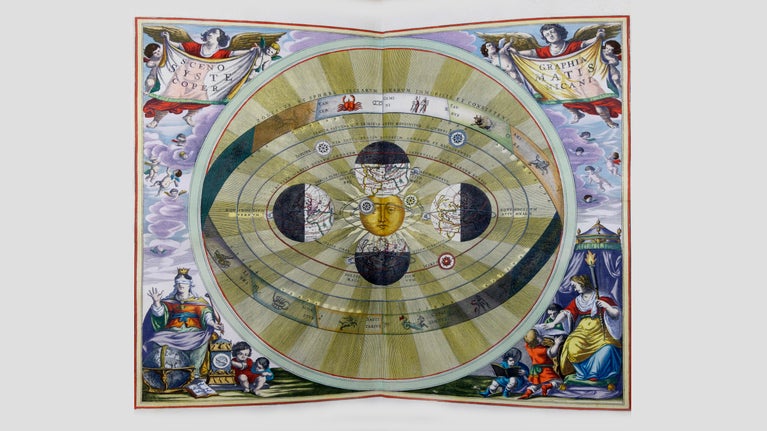‘Spectacular’ rare 17th-century ‘star atlas’ from Golden Age of Dutch map-making goes on display for first time

One of the world’s finest and rarest 17th century atlases is set to go on display for the first time at the National Trust’s Blickling Estate in Norfolk, following specialist conservation.
Andreas Cellarius’ Harmonia macrocosmica is an outstanding example of Dutch cartography that experts class as a creative triumph of the Dutch Golden Age. Only about 20 copies of the atlas, published in 1661, are thought to survive worldwide.
The atlas describes theories about the movement of the stars, as they were understood in the 1600s. It was created at a pivotal time when thinking was shifting from the Ptolemaic belief that the Earth is at the centre of the universe, to the heliocentric belief that the sun is at the centre of our Solar System and the planets, moons, and other celestial bodies move around it.
It was during this period that Leuven, Antwerp, and Amsterdam became centres for the production of maps that combined lavish illustrations with advances in mapmaking techniques and scientific theories.
Little is known about the German-born author, Andreas Cellarius, who was a schoolteacher and then school rector. He wrote a book on military architecture and later on the history of Poland, and it may have been his Amsterdam-based publisher, Johannes Janssonius, who suggested he turn his attention to the celestial. A minor planet orbiting between Mars and Jupiter, ‘12618 Cellarius’, was discovered in 1960 and named in his honour.
Blickling librarian, Rebecca Feakes, said: “Some of the ideas in the book seem strange to us now, but the stunning illustrations leave no doubt that Cellarius and his contemporaries were just as awestruck by the night sky as we are today.
“This large folio was meant to be displayed and celebrated for its size and opulence. Owning it told the world about your status and intelligence.”
Rebecca continued: “It was aimed at wealthy, learned collectors who valued it as a reference work, beautifully produced. The gold-tooled bindings and hand-coloured plates are spectacular; it is the height of the copper engraver’s skill.”
The atlas is one of 10,000 items – including atlases, manuscripts, early books and pamphlets – in Blickling’s library, one of the most important in the care of the National Trust. The collection was gifted to Blickling’s then-owner John Hobart in 1742, by his uncle, scholar Richard Ellys and due to its size, it is still being catalogued and studied today.
The Cellarius atlas is one volume from a lavish set of 14 atlases by great Dutch Golden Age mapmakers, which have been at Blickling since they were acquired in the 17th century.
Over three months, a book conservation specialist stabilised the binding of the atlas, which was dry and brittle, and also the text block and plates, which had suffered from tears and splits.
Clare Prince, Book Conservator responsible for the work, said:
“The parchment on the spine of the atlas was extremely dry and fractured, with large areas of loss, leaving it almost impossible to handle. It was not in a state that it could be used or displayed to visitors. Many of the pages within were torn and crumpled and in need of repair. Beautiful, hand-coloured, engraved plates had become loose and were at risk of further damage.
“As the spine was in such a poor state of repair the decision was taken to remove the remaining fragments and line them with Japanese paper. The losses were then infilled and the spine built-up using laminates of Japanese paper. The endbands were resewn, and the repaired spine was re-adhered. Within the book many paper repairs were carefully carried out and the decorative plates reattached.”
Blickling Estate’s Property Curator, Megan Dennis, added:
“Thanks to our supporters, we have been able to carry out this conservation work so that our visitors can now explore this wonderful atlas and all that it has to offer. Researchers are once more able to learn from this fascinating book and we’re looking forward to having it open and on display for everyone to enjoy for the first time this November.
“It’s such a special item in the collection and now that it’s been conserved, we’ve decided to use it as the inspiration for this year’s Christmas experience. With a Journey to the Stars theme, visitors will be able to view the atlas as well as explore star-filled rooms including a planetarium, the northern lights and star-inspired family activities.”
The atlas will be on display in Blickling’s Long Gallery, alongside reproduction pages showing some of the remarkably unfaded illustrations.
Blickling’s atlases are being studied as part of a National Trust research project into the effect of light on collections items. It is hoped that by understanding how different pigments and materials fade on light exposure, curators will be able to plan the display of items without damaging them. Using exposure to controlled amounts of light, and monitoring the changes to the objects, the conservation charity will learn which materials are most fragile and how to balance access to precious treasures whilst keeping them safe for future generations.
The Star Atlas will be on display at Blickling Estate from Saturday 30 November until Sunday 5 January (Closed 24 and 25 December).